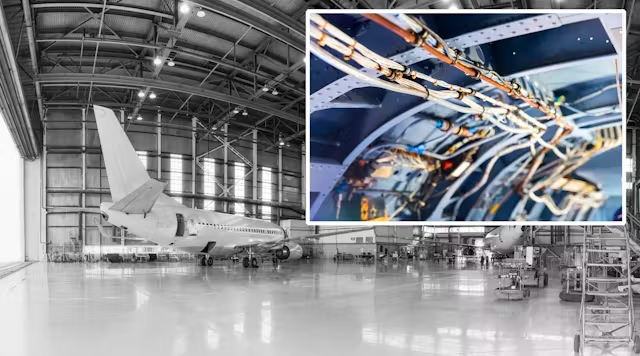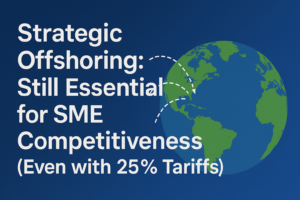
Prepared for: C-Suite Executives in Aerospace Manufacturing
Focus: Commercial Aircraft Sector
Executive Summary
In the competitive landscape of aerospace manufacturing, optimizing production processes is crucial. Offshoring to countries like India and Vietnam offers significant advantages, including cost reductions, access to advanced technologies, streamlined supply chain management, and adherence to stringent quality standards. This paper explores these benefits in detail, providing a comprehensive guide for decision-makers considering offshoring strategies.
1. Introduction
The aerospace industry is characterized by its complex supply chains and the necessity for precision in manufacturing. As global competition intensifies, companies are exploring offshoring as a strategic approach to maintain competitiveness. This paper focuses on the offshoring of wiring harnesses and electronic subassemblies—critical components in commercial aircraft—to India and Vietnam, countries that offer favorable conditions for such operations.
2. The Business Case for Offshoring to Non-Tariff Countries
2.1 Financial Benefits
Cost Optimization: Offshoring to India and Vietnam allows aerospace companies to capitalize on lower labor and operational costs. These countries offer a skilled workforce at a fraction of the cost compared to Western nations, leading to substantial savings in manufacturing expenses.
Resource Accessibility: Proximity to abundant raw materials and established supplier networks in these regions further reduces procurement costs, enhancing overall financial efficiency.
2.2 Technological Advancements
Advanced Manufacturing Capabilities: India and Vietnam have made significant investments in their manufacturing infrastructures, offering specialized capabilities in aerospace production. Companies like Mahindra Aerospace in India have achieved AS9100 Rev.D certification, underscoring their commitment to high-quality manufacturing standards.
Automation and Robotics: The integration of automation and robotics in manufacturing processes is prevalent in these countries, leading to enhanced precision and efficiency in production. This technological adoption ensures consistency in the quality of complex aerospace components.
Technology Transfer and Intellectual Property Protection: Both India and Vietnam have strengthened their intellectual property laws, providing a secure environment for technology transfer. Collaborating with certified partners in these countries ensures that proprietary technologies are safeguarded during the manufacturing process.
2.3 Business Efficiency and Operational Advantages
Supply Chain Optimization: Offshoring enables companies to streamline their supply chains by leveraging the logistical advantages of India and Vietnam. Established transportation networks and proximity to key markets facilitate efficient distribution, reducing lead times and inventory costs.
Scalability and Flexibility: The manufacturing sectors in these countries are equipped to handle varying production volumes, offering scalability that aligns with market demands. This flexibility allows aerospace companies to adjust production levels without significant capital investments.
Favorable Trade Policies: As non-tariff countries, India and Vietnam provide a trade-friendly environment, minimizing the complexities and costs associated with tariffs. This advantage simplifies the import and export processes, contributing to smoother international operations.
3. Quality Considerations and Risk Mitigation
3.1 Enhanced Quality Standards
Adherence to International Certifications: Manufacturers in India and Vietnam have obtained critical aerospace certifications, such as AS9100, demonstrating their commitment to quality management systems. For example, Sanghvi Aerospace in India is both AS9100 and ISO 9001 accredited, highlighting their dedication to maintaining high-quality production standards.
Robust Quality Control Processes: These certified manufacturers implement stringent quality control measures, including comprehensive testing and traceability protocols, ensuring that all products meet the rigorous standards required in aerospace applications.
3.2 Risk Management in Offshore Manufacturing
Geopolitical Stability: India and Vietnam have established themselves as stable environments for foreign investments, with governments actively supporting industrial growth and foreign partnerships. This stability reduces the risks associated with geopolitical uncertainties.
Diversification of Supply Base: Offshoring to these countries allows aerospace companies to diversify their supply chains, mitigating risks related to over-reliance on a single source. This diversification enhances resilience against potential disruptions.
Disaster Preparedness: Manufacturers in these regions have developed contingency plans to address natural disasters and other unforeseen events, ensuring continuity in production and supply.
4. SKU Selection Criteria for Offshoring
Volume Considerations: High-volume, mature-stage products with stable demand are ideal candidates for offshoring. The established manufacturing capabilities in India and Vietnam can efficiently handle large-scale production runs, ensuring consistency and cost-effectiveness.
Complexity Assessment: While these countries possess advanced manufacturing technologies, it is prudent to offshore products with moderate complexity to capitalize on existing expertise and infrastructure.
Lifecycle Stage: Products in the maturity phase of their lifecycle, where designs are stable and well-documented, are suitable for offshoring. This stability minimizes the risks associated with design changes and allows for efficient production planning.
5. Case Study Examples
Mahindra Aerospace: An example of successful offshoring is Mahindra Aerospace’s acquisition of Australian aircraft manufacturer GippsAero. This strategic move enabled the company to integrate advanced manufacturing techniques and expand its global footprint, demonstrating the benefits of leveraging international partnerships.
Sanghvi Aerospace: By obtaining AS9100 certification, Sanghvi Aerospace has positioned itself as a reliable supplier of high-quality wiring harnesses and electronic subassemblies, exemplifying the advantages of adhering to international quality standards in offshore manufacturing.
6. Conclusion
Offshoring the production of complex aerospace wiring harnesses and associated electronic subassemblies to non-tariff countries such as India and Vietnam is a highly strategic decision for aerospace companies focused on improving their cost structure, accessing specialized manufacturing expertise, and maintaining quality without compromise.
The combination of reduced labor costs, advanced automation technologies, streamlined supply chains, and adherence to global quality standards presents a compelling business case. Moreover, these countries offer a favorable geopolitical environment and growing industrial ecosystems that can support both high-volume production and long-term business relationships.
For companies in the commercial aerospace sector, focusing on the right SKUs—particularly high-volume, mature products—can significantly accelerate the return on investment. A phased approach to offshoring, beginning with less complex products and progressively transitioning more critical components, will mitigate risks while maximizing benefits.
Aerospace executives and decision-makers must adopt a forward-thinking mindset to take full advantage of these opportunities, ensuring they select the right partners, rigorously assess quality standards, and maintain a robust risk management framework.
7. Bibliography
- Aviation Week & Space Technology – Reports on aerospace manufacturing trends and market forecasts.
- Deloitte Insights – White papers on global supply chain strategy and offshoring best practices.
- McKinsey & Company – Case studies on supply chain diversification and China+1 strategy.
- Aerospace Manufacturing and Design – Industry updates on certification standards and manufacturing innovations.
- Sanghvi Aerospace – Corporate site for AS9100 certified aerospace wiring harness production in India (https://www.sanghviaerospace.com).
- Mahindra Aerospace – Overview of advanced aerospace manufacturing in India (https://en.wikipedia.org/wiki/Mahindra_Aerospace).
- ITI Manufacturing – Offshore manufacturing insights and cost-benefit analysis (https://itimanufacturing.com).
- Redstone Manufacturing – Discussion on outsourcing advantages (https://redstonemanufacturing.com).
#aerospacemanufacturing #offshoresupplychain #wiringharness #electronicsubassembly #IndiaManufacturing #VietnamManufacturing #AS9100 #aerospacequality #aerospacecostsavings #automation #robotics #intellectualproperty #commercialaircraft #supplychainoptimization #aerospacelogistics #riskmanagement #offshoremanufacturing #aerospacepartners #geopoliticalstability #manufacturingautomation #aerospacecertifications #highvolumemanufacturing #offshoringbenefits #globalmanufacturing #nonTariffCountries #scalability #costefficiency #productlifecycle #diversifiedsupplychain #commercialaerospace
#QualityControl #VietnamManufacturing #Manufacturing2024 #OffshoreManufacturing #REDUxEngineering #QualityAssurance #ManufacturingTips #TechInManufacturing #AuditProcess #InspectionProcess






